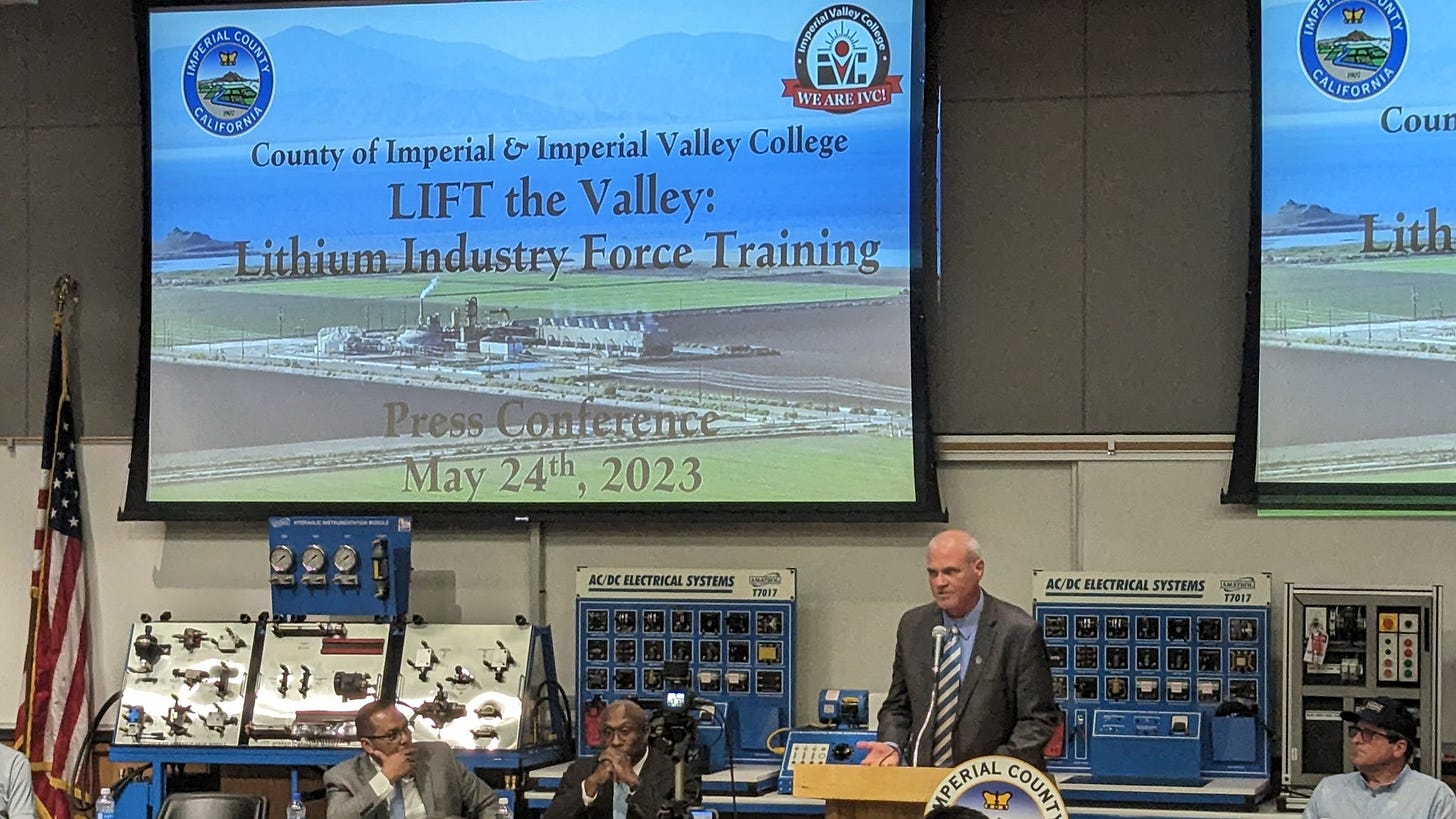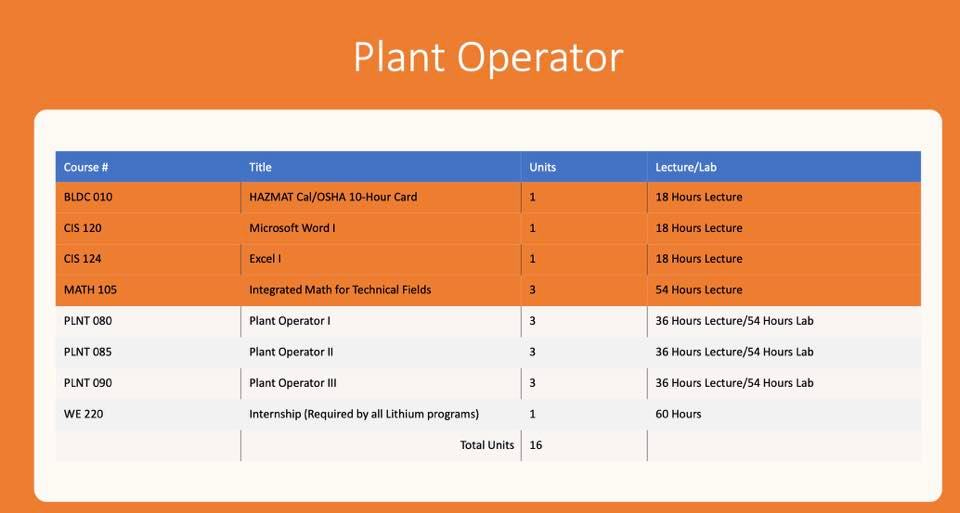Issue 23: Lithium Valley faces significant obstacles in the region, new report finds
For the Lithium Valley to succeed and thrive, northern Imperial County will need paved roads, waste facilities, a well-trained technical workforce, and housing, according to the report.

Fresh this Week
IVC Launches Lithium-Related Program
Imperial Valley College will begin offering a one-year, lithium-focused program this fall. The Plant Operator Program is set to begin on August 14, 2023, and end on June 7, 2024. Registration for the program will open July 5, 2023.
IVC administrators say there will be two cohorts of about 25-30 students each. One cohort will be during the day and the other during the evening.
Students will have the opportunity to get certified with the Smart Automation Certification Alliance (SACA) and the National Coalition of Certification Centers (NC3).
Two other lithium-related programs — Instrumentation Technician and Chemical Lab Technician — will be offered in the fall of 2024.
Ford Agrees to Buy Lithium from EnergySource Minerals
Ford announced this week that it will be purchasing an unspecified amount of lithium from the Salton Sea’s geothermal brine through EnergySource Minerals.
EnergySource will supply Ford with lithium hydroxide produced at ESM's Project ATLiS, which is expected to be operational in 2025. Neither company has disclosed how much lithium hydroxide will be sold to Ford or where it will be shipped once it is ready for battery manufacturing.
Like most car makers, Ford is entering the electric vehicle market and as a result has sought to secure lithium minerals that make the batteries that power those EVs. In addition to sourcing its lithium from the Imperial Valley, Ford will also buy the mineral from North Carolina-based Albemarle, Compass Minerals in Utah, Nemaska Lithium, and SQM in Chile.
Want to join the discussion on developments of the Lithium Valley? Join the Facebook Group and subscribe to this newsletter for updates.
Between the Lines

Lithium Projects Move Forward Despite Infrastructure Obstacles
At least two lithium-related projects in northern Imperial County are moving forward despite numerous infrastructure and workforce obstacles identified in a new report drafted this month.
EnergySource Minerals and Controlled Thermal Resources say they plan to begin construction of their respective plants some time this year — though this phase of their projects were previously announced to begin in 2022.
But the first draft of a new study made public this month offers a dose of reality facing the northern part of Imperial County where those projects will live.
The findings are sobering.
The 365-page Lithium Valley Specific Plan Baseline Report is a snapshot of the existing conditions in the 51,786-acre land area adjacent to the southeastern bend of the Salton Sea in Imperial County. The Specific Plan report was prepared by Rick Engineering Company, one of the consultants hired by county leaders to oversee the study.
Among the findings of the study:
Imperial County has very high rates of linguistic isolation, individuals with disabilities, poverty, and unemployment.
The Specific Plan should include policies and programs for education, training, pre-apprenticeships, and certifications for students and adults interested in future jobs in geothermal, mineral extraction and renewable energies.
Imperial County may consider conducting a more detailed analysis of housing needed for potential workers.
Wastewater systems in the Study Area are very limited.
Roadway widths, pavement conditions, and bridge capacities create limitations on the existing roadway network.
Imperial County should evaluate the viability of using recycled water to augment future water demands under the Specific Plan.
The findings are significant in that they reveal the degree of underdevelopment in the region, mostly unincorporated land next to Calipatria and Niland.
For example, the majority of existing roads and roadways in the northern half of the studied area (north of Sinclair Road) are unpaved and paved access in that area is not provided, the study finds. Additionally, many of the area’s roadways may be too narrow for two-way heavy truck traffic, with pavement widths less than 24 feet along some roadway segments of English Road, Wilkins Road, Brandt Road, Kalin Road, Gentry Road, and Lack Road.
Equally pressing for the region is the development of wastewater systems.
Unincorporated areas of the county are believed to have little or no wastewater infrastructure except for septic systems, the report says. One wastewater treatment facility in Calipatria has been recommended for an upgrade by 2025.
The report says that future development in the region will require extensive installation of trunk sewer mains, service lines, lift stations and upgrades to wastewater treatment facilities to handle future flows. It is not yet known how much it would cost for such upgrades or when those upgrades would happen.
Lithium miners in the region have previously claimed that their projects would use minimal amounts of water. EnergySource Minerals, for example, has said that it would use up to 8 acre feet — or about 2.6 million gallons — of water per day once its lithium extraction plant is fully operational.
And while the Imperial Valley enjoys some of the most generous water rights in the West, drought conditions in the Colorado River have put additional strain on water resources. And the study makes note of it.
Even when the Imperial Valley’s water supply is vast — 2.6 million acre-feet of water from the Colorado River — the study says that this volume presents challenges to sufficiently support future demand.
Additionally, the study says that the region will require improvements to the existing lines that distribute water, including transmission lines, service laterals, booster pumps and associated appurtenances.
But perhaps one of the most glaring challenges for the nascent lithium industry is the region’s workforce and a lack of housing stock available to a potential growth in lithium-related jobs.
The study finds that “operating a wider range of resource-based industries in the Salton Sea area will require adding employment across a range of technical fields. This may require bringing in workers from outside the local area and this in turn may create the need to generate additional affordably priced housing for this new workforce.”
“If the local area is unable to create sufficient housing for workers or is otherwise unable to attract the necessary workforce, this would present significant constraints on industry expansion,” the study adds.
The two local higher education institutions — Imperial Valley College and San Diego State University — are currently developing education and training programs for local workers to gain knowledge and experience to work in the lithium industry. SDSU’s $80 million STEM campus just east of Brawley is expected to open in the fall of 2025, the university says.
Imperial Valley College this fall will begin offering a Plant Operator Program, and two other programs for Instrumentation Technician and Chemical Lab Technician in the fall of 2024.
The Lithium Valley Specific Plan Baseline Report together with a Programmatic Environmental Impact Review are part of a comprehensive plan to expedite the processing and permitting time for future projects, whether they be additional geothermal plants, lithium extraction facilities or a battery manufacturing facility.
Both EnergySource Minerals and Controlled Thermal Resources are set to begin construction because they have obtained the legally required permits to do so.
Statevolt, the company that’s proposing to build a battery manufacturing facility in the Imperial Valley, has yet to secure such permits though it had previously projected to begin construction in 2023.




